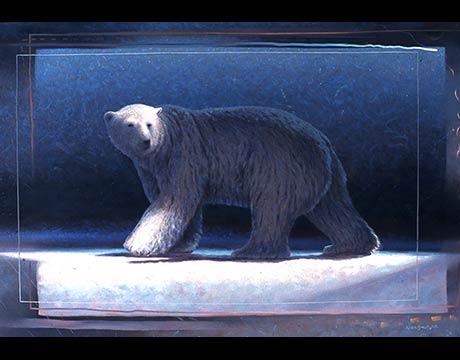Gallery - Past Exhibitions - 2000 - Bylot Island
(Click image for slideshow)
In early July of 2000 I returned to Bylot Island with Mike Beedell. (see Bylot Island '99)The plan was to continue from Tay Bay, where we left off in the fall of 1999, paddling our solo kayaks clockwise around the island. By air plane, we dropped caches of food and supplies in bear proof barrels in two locations along the island' s north shore.
After being dropped off we watched scores of polar bears hunting seals on the sea ice in front of our camp, before a two day gale from Bears of Bylot #1, mixed mediathe east took out the winter's ice.(a month earlier than usual) We then began our long journey east along Lancaster Sound. The early dispersion of ice enabled us to proceed, however without some ice coverage large waves can build unabated making paddling, landing and embarking difficult, and also without sea ice the polar bears all come to land.
At the massive headlands of Cape Hay we paddled for three kms. under a 1000 ft. vertical rock wall covered with a nesting colony of Thick-billed Murres, estimated at close to a million birds. The north shore is even more spectacular than the south coast; long spines of snow capped mountains, multitudes of flowing glaciers and deeply carved shore cliffs, sculpted in a labyrinth of turrets and tunnels. One massive glacial face extended for 5 kms., periodically releasing icebergs into the swells of the North West Passage. We were travelling the entrance of the same passage that had stymied explores and captured the publics imagination for 4 centuries. In Pierre Berton' s words, it was The Arctic Grail.
Air Traffic. etching We discovered a den of Arctic foxes, a rare Gyrfalcon nest with 3 adolescent young, a clutch of snowy owl chicks and countless ptarmigan, geese, duck, and other water fowl. Along the shore were remains of Paleo-Eskimo sites littered with hundreds of ancient bones of bowhead, narwhal, caribou, polar bear, and walrus. Off shore hundreds of beluga whales were moving west. At a place called Maud Bight we found the wreck of a whaling ship from the 1800' s.
As we proceeded the polar bears became more numerous, sometimes we saw a dozen a day. Ursa Major...Most bear were wary of us, likely having had experiences with Inuit hunters at some point in their past. However these ice giants are also fearless, curious and cunning by nature, and if hungry, humans can become their prey. We felt our biggest risk was when we slept. We had a number of bears enter our camp, but Mike would usually hear them, and on getting up, the bears would move off.
Northwest Passage, etching However after 10 days, the lack of sleep was catching up with us. At about 1:00 in the morning, Mike and I were woken from a deep sleep by a thunderous slam on the roof of our tent. We both bolted upright in our sleeping bags, looked at each other, silently hoping it wasn' t what we knew it was. The silence was broken seconds later by another blow, this one stronger. The polar bear slashed through the outer fly and inner nylon tent, breaking two of the tent poles, causing further ripping. The tent was a 2 person North Face expedition tent with double doors. Mike grabbed the 12 gauge shotgun and pumped a plastic bullet in the firing chamber, as I unzipped my door to see where Nanook was standing. He was still right beside my tent door, as Mike fired the shotgun through the tent in line to where he was standing. After the blast, we cautiously peered out. The polar bear was confused but seemingly unhurt, slowly backing away from our camp. The rest of the night we repaired the broken poles and sewed up the torn tent. We thus added acute sleep deprivation to the list of trials endured on this wild, incredible island.
:: BACK TO GALLERY






